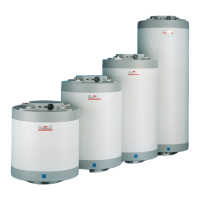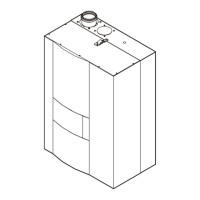- 36 -
COMMISSIONING
2 - FILLING THE SYSTEM WITH WATER
- Filling the system:
• Open the heating output/return valves if neces-
sary,
• Open the cold water inlet valve,
• Fill the installation slowly (to aid degassing)
using the disconnector filling valves.
• Close the filling valves again,
• Check that it is watertight,
• Drain the entire installation, including the ra-
diators. Continue to fill until a pressure of
1,5
bar is obtained.
- To FCX with DHW hot water tank:
• When the boiler is under pressure and the hot
water circulating pump is supplied, the water
tank coil will be purged when the circulating
pump is started.
• Filling the tank:
. Fill the tank with water using the safety con-
trol box (rep. 18, fig. 45 - page 28 et fig. 47 -
page 30 - chapter IV - INSTALLATION) of
the system, and making sure a hot water tap
is open,
. When the tank is filled, check that the tank
access door is tightened,
3 - OIL INLET
The burner must be off when filling the
tank with oil. Only start it up after a mi-
nimum time of one hour to prevent any
of the various filters from clogging owing to the
suction of deposits disturbed in the tank when it
is filled.
4 - PRE-COMMISSIONING CHECK
- Check that the boiler is filled with water and under
pressure (1,5 bar) and that there are no leaks,
- Check that the electrical connection of the boiler
is correct: 230 V, 50 Hz, connection to earth in
conformity, polarities respected,
- Check that the combustion product drainage flue
is correctly assembled, airtight and free of all obs
-
tructions.
- Check that the ventilation units in the heating sys-
tem are free from any obstructions and that they
conform to the necessary regulations.
- Check that the condensate siphon of the flues is
filled with water (filled via the condenser cover)
(
fig. 63, section 2 - page 41 - chapter VI - MAIN-
TENANCE),
- Check that the condensate outlet is connected
properly and that there are no leaks.
5 - USER INFORMATION
It is up to the installer to inform the user as to how to
use the appliance. In particular, the user must be in
-
formed about the safety devices and their use and
about the need for regular maintenance by a quali
-
fied professional.
!
